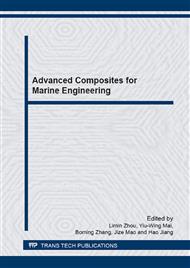[1]
M. Russ, S.S. Rahaterkar, K. Koziol, B. Farmer, H. Peng, Length-dependent electrical and thermal properties of carbon nanotube-loaded epoxy nanocomposites, Composites Science and Technology. 81(2013) 42-47.
DOI: 10.1016/j.compscitech.2013.03.011
Google Scholar
[2]
J. Gou, Y. Tang, F. Liang, Z. Zhao, D. Firsich, J. Fielding, Carbon nanofiber paper for lightning strike protection of composite materials, Composites Part B: Engineering. 41(2010) 192-198.
DOI: 10.1016/j.compositesb.2009.06.009
Google Scholar
[3]
H. Kawakami, P. Feraboli, Lightning strike damage resistance and tolerance of scarf-repaired mesh-protected carbon fiber composites, Composites: Part A. 42 (2011) 1247-1262.
DOI: 10.1016/j.compositesa.2011.05.007
Google Scholar
[4]
M. Gagne, D. Therriault, Lightning strike protection of composites, Progress in Aerospace Sciences. (2013).
Google Scholar
[5]
M. Louis, S.P. Joshi, W. Brockmann, An experimental investigation of through-thickness electrical resistivity of CFRP laminates, Composites Science and Technology. 61(2001) 911-919.
DOI: 10.1016/s0266-3538(00)00177-9
Google Scholar
[6]
N. Angelidis, C.Y. Wei, P.E. Irving, The electrical resistance respongse of continuous carbon fiber composite laminates to mechanical stain, Composites: Part A. 35 (2004) 1135-1147.
DOI: 10.1016/j.compositesa.2004.03.020
Google Scholar
[7]
K.W. Tse, C.A. Moyer, S. Arajs, Electrical conductivity of graphite fiber-epoxy resin composites, Materials Science and Engineering. 49 (1981) 41-46.
DOI: 10.1016/0025-5416(81)90131-2
Google Scholar
[8]
JBaur, E Silverman, Challenges and opportunities in multifunctional nanocomposite structures for aerospace applications, MRS bulletin. 32 (2007) 328-334.
DOI: 10.1557/mrs2007.231
Google Scholar
[9]
A. Moisala, Q. Li, I.A. Kinloch, A.H. Windle, Thermal and electrical conductivity of single- and multi-walled carbon nanotube-epoxy composites, Composites Science and Technology. 66 (2006) 1285-1288.
DOI: 10.1016/j.compscitech.2005.10.016
Google Scholar
[10]
W. Bauhofer, J.Z. Kovacs, A review and analysis of electrical percolation in carbon nanotube polymer composites, Composites Science and Technology. 69 (2009) 1486-1498.
DOI: 10.1016/j.compscitech.2008.06.018
Google Scholar
[11]
N. Xie, Q. Jiao, C. Zang, Study on dispersion and electrical property of multi-walled carbon nanotubes/low-density polyethylene nanocomposites, Materials and Design. 31 (2010) 1676-1683.
DOI: 10.1016/j.matdes.2009.02.032
Google Scholar
[12]
ASTM D4496 – 04, Standard test method for D-C resistance or conductance of moderately conductive materials.
Google Scholar
[13]
J. Xiao, Y Li, W.X. Fan, A laminate theory of piezoresistance for composite laminates, Composites Science and Technology. 59(1999) 1369-1373.
DOI: 10.1016/s0266-3538(98)00176-6
Google Scholar
[14]
N. Athanasopoulos, V. Kostopoulos, Prediction and experimental validation of the electrical conductivity of dry carbon fiber unidirectional layers, Composites: Part B. 42 (2011) 1578-1587.
DOI: 10.1016/j.compositesb.2011.04.008
Google Scholar
[15]
R.H. Knibbs and J.B. Morris, The effects of fibre orientation on the physical properties of composites, Composites. 5. 5 (1974) 209-218.
DOI: 10.1016/0010-4361(74)90141-4
Google Scholar


